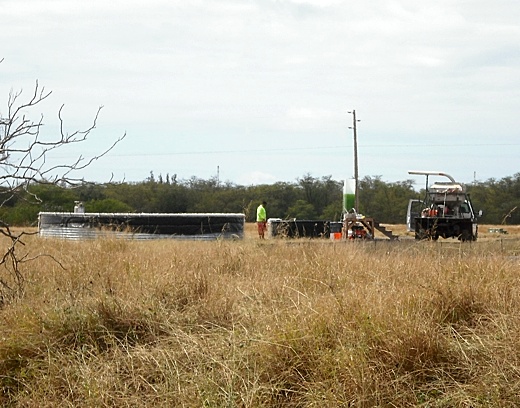In Our Opinon on 27 March 2011 in The Garden Island -
(http://thegardenisland.com/news/opinion/editorial/article_63f6adc6-5842-11e0-97fa-001cc4c03286.html)

Image above: Sunrise Capital employee adding chemicals to test pit in March 2010. Photo by Juan Wilson.
As if flushing up to 20 million gallons a day of shrimp effluent into the ocean was not enough to cause a public uproar, Sunrise Capital has effectively muscled $250,000 from taxpayers to put toward the Kekaha facility.
We must do better to protect our limited resources — environmental and financial.
Sunrise Capital claims seabirds are to blame for the facility having to shut down twice in the last seven years due to shrimp infected with the untreatable white spot syndrome virus.
The Missouri-based company says the birds gorged themselves on contaminated shrimp dumped at the landfill, flew to the nearby farm, vomited the shrimp into the ponds and caused the outbreak.
That’s quite a tale. Some county officials think so too, but due to poor solid waste planning they found themselves in a bind.
County officials have said if they had not been racing the clock to expand the island’s sole landfill before it reaches capacity, there would have been sufficient time to fight these absurd claims.
They note that it would have cost millions of dollars — instead of hundreds of thousands — if the county would have gone through a lengthy contested case hearing. This is because the trash would have piled up on top of the space reserved for capping the landfill, requiring the county to re-handle the garbage after finally receiving the expansion permit.
The county should have made more of an effort to buy itself time to do what’s right by putting pressure on the state Department of Health, which administers the EPA permit the farm needs to operate.
There are certainly myriad reasons the county could have cited to effectively prolong the DOH’s permitting process while handling the contested case and figuring out what to do with all our rubbish.
For instance, county officials could have played the tourism card, arguing that hundreds of millions of gallons of shrimp waste in the water each week does not exactly nurture a recreational resource visitors would want to enjoy.
It would be nice if our government by the people, for the people, was already looking out for us based on those concerns, not to mention the impact to locals who routinely utilize the area for fun, fishing and cultural practices.
Instead, the county signed a settlement with Sunrise in October that will cost taxpayers a quarter-million bucks in exchange for the company withdrawing its contested case filing against the proposed landfill expansion.
Sometimes it costs more to do what’s right. We shouldn’t deplete our moral reserves to save paper.
For the sake of argument, let’s assume the county already had a materials recovery facility up and running and we were diverting more trash from the landfill than we were dumping into it. In essence, let’s assume we planned properly for our solid waste needs.
The county should still have spoken up on behalf of its residents and visitors who depend on the health of the island’s natural resources. And so should the state. At least the feds did in this case. The EPA provided a laundry list worth of issues the DOH should address before letting Sunrise pollute the Pacific.
Concerned citizens were basically left out to dry as the DOH in January approved the National Pollutant Discharge Elimination System permit.
Since we can’t undo what’s been done, we strongly urge the government entities tasked with monitoring this monstrosity to do so with all due diligence.
We can’t fathom there being no significant environmental impact with that amazing amount of output.
Even assuming all monitoring occurs as intended, do we really want to put such duress on a fragile ecosystem that takes years to recover?
While the DOH report on the permit says there will be no increased shark presence despite the billions of gallons of shrimp waste pouring into the Pacific each year, common sense says otherwise.
Wouldn’t the shrimp remains be eaten by the little fish who are in turn eaten by the bigger fish who are then shark bait?
In addition to logic, we tend to rely on the surfers out there every day who reported increased sightings and avoided the area entirely when it was operating a few years ago.
The bottom line is two-fold: the county should have stood up for what is right, despite the financial burden; and this facility should never have received a permit in the first place due to its likely environmental impacts.
While we absolutely want to bring new jobs to the island, we have an obligation to maintain high standards. Kaua‘i must be preserved as the special place it is for the sake of this generation and the next.
See also:
TGI: County agrees to $250K settlement with shrimp farm
(http://thegardenisland.com/news/local/article_27b20748-545a-11e0-9c2c-001cc4c03286.html)
Ea O Ka Aina: Kekaha Shrimp Farm Discharge 9/3/10
Ea O Ka Aina: Kauai Shrimp Waste Dump 3/19/10
Ea O Ka Aina: Kauai Shrimp Effluent Problem 3/12/10
Island Breath: Kauai Shrimp to dump in ocean 8/21/06
Island Breath: Kauai's Crustacean Crisis 4/23/04 .
1 comment :
Good letter the next day (today) from Carl Berg on this in the paper.
Post a Comment